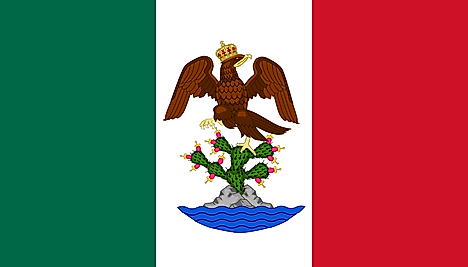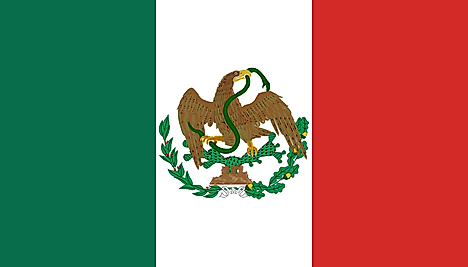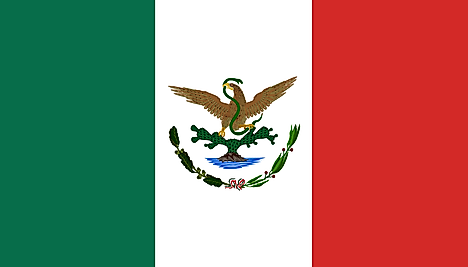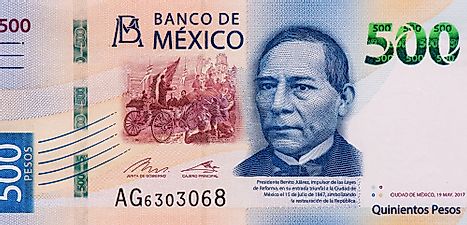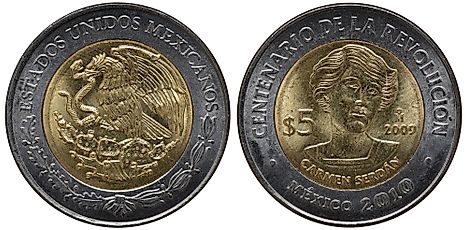Flags, Symbols, & Currencies of Mexico
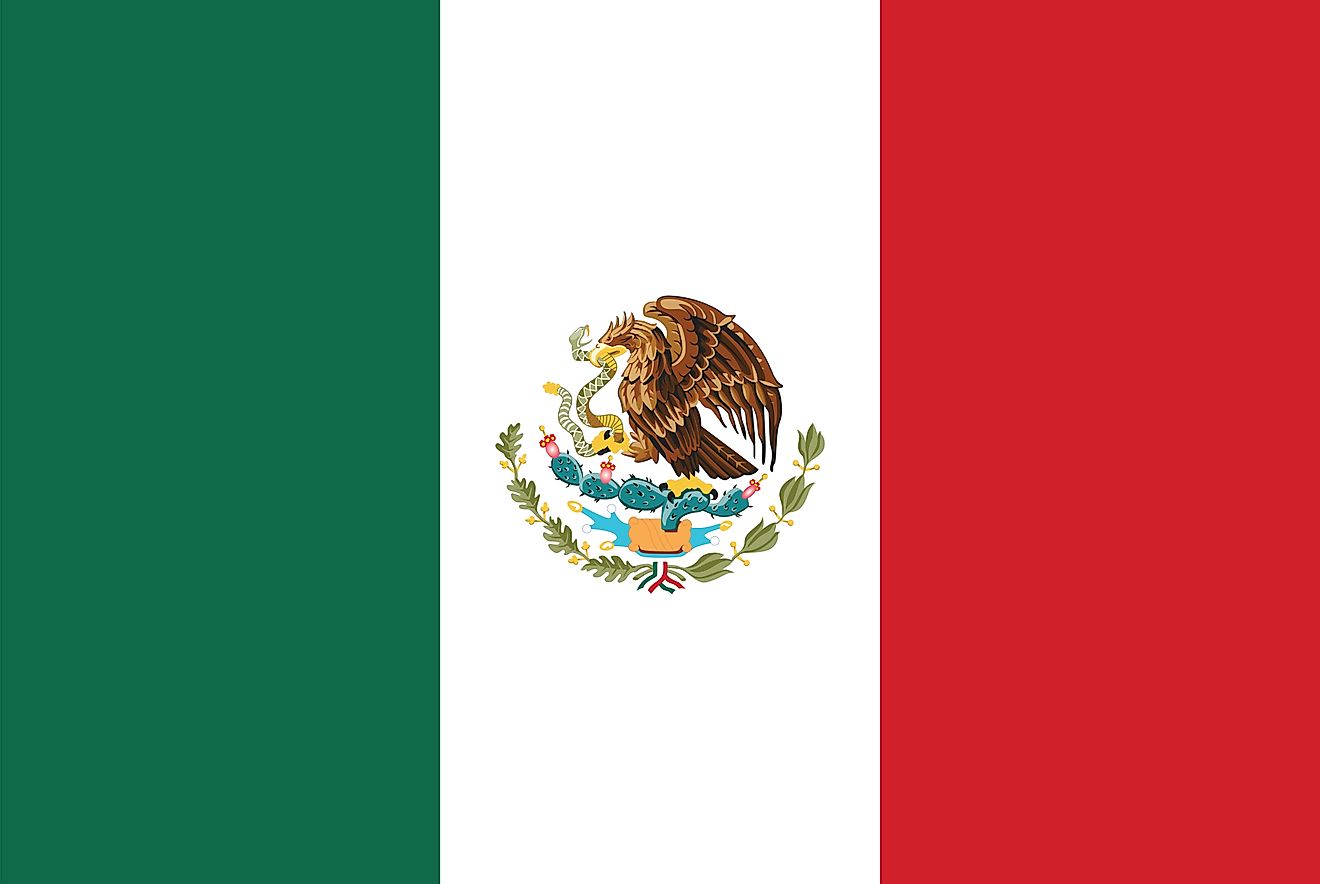
Although the current official flag of Mexico was adopted on September 16, 1968, it was legally recognized in 1984. tThe flag consists of hree equal vertical bands of green (hoist side), white, and red with Mexico's coat of arms (an eagle with a snake in its beak perched on a cactus) centered in the white band. The national flag has a height to length proportion of 4:7.
Originally, the colors of the Mexican flag held different meanings than today. The green stripe was said to represent Mexico’s independence from Spain. The color red indicated the union between the Americas and Europe, as the elite class still identified with its European roots. The white color was established to symbolize the purity of the Catholic religion. Today, the meaning behind the colors has changed. Green represents hope, white symbolizes purity, and red stands for the blood of the heroes who fought for independence.
When used at large gatherings, military individuals in uniform must salute the flag. Civilians cover their heart with their right hand, palm facing the ground, to show respect. Anytime the national anthem is played or sung, the flag should also be displayed. On national holidays and significant dates, both civilians and the government fly the flag. When Mexico participates in the Olympics, the president gives the flag bearer a flag to be carried to the host city. Mexico has celebrated Flag Day on February 24 since 1937.
History of the flag
Traditionally, different communities throughout Mexico used flags to represent their people and cultures. One legend suggests that some of the first flags displayed were by the Aztec culture whose principal god had told them to build a new city where they found an eagle perched on a cactus with a snake in its mouth. This image went on to become central to several versions of the Mexican flag, including the current one. The practice of a different flag for different communities continued well into the War of Independence. During this war, each militia carried its flag, many of which displayed the Catholic image of the Virgin Mary. One of these rebel flags depicted the image of the Virgin of Guadalupe and became famous after the Battle of the Grito de Dolores in September of 1810. Another held the Virgin Mary and the image of a crowned eagle sitting atop a cactus. The Revolutionary Army utilized red, white, and blue vertical stripes.
The first official flag was declared in 1821, which was the first year that Mexican sovereignty was recognized. This flag utilized green, white, and red vertical stripes and the symbol of an eagle wearing a crown. The crown was meant to represent the then-Empire. The Empire was abolished, and the country became a federal republic in 1823. In this year, the second official flag was established. In this version, the vertical stripes were maintained, the eagle no longer wore a crown, and a serpent was shown in its right talon. It also added an oak and laurel branch. The first republic was dissolved in 1864 and the third official flag, representing the Second Mexican Empire, was declared. This flag used the same color scheme, but instead of the central image of an eagle, it displayed a crowned eagle in each corner. The country underwent several other changes in government and to the flag, but always maintained the same basic overall appearance and inclusion of the eagle.
Symbols of Mexico
National Coat of Arms of Mexico
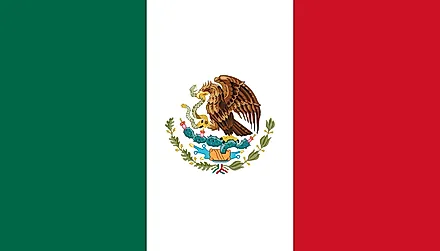
The coat of arms, also used as the Seal of the United Mexican States, was adopted in 1968 and has been an important symbol of Mexico's culture and politics for years. It depicts a Mexican Golden Eagle perched on a prickly pear cactus eating a snake. Below the cactus are oak and laurel leaves joined by a small ribbon bearing the national flag colors. The golden eagle is considered the bird of Mexico. This symbolism had strong religious connotations to the Tenochtitlan people. To the Europeans, it symbolized the triumph of good over evil.
National Anthem
- Anthem Title: Himno Nacional Mexicano (Mexican National Anthem)
- Music composer: Jaime Nunó
- Lyricist: Francisco González Bocanegra
- Date of Adoption: 1943
"Himno Nacional Mexicano" was adopted in 1943 as Mexico's official anthem. However, the anthem dates back to 1854 when it was used for the first time. The lyrics were written by poet Francisco Gonzalez Bocanegra and set to music by National Band conductor, Jaime Nuno Roca. The anthem consists of a chorus and ten stanzas. However, only four stanzas (1st, 5th, 6th, and 10th stanzas) and the chorus are often used. The chorus is sung first then repeated after every stanza.
Himno Nacional Mexicano
Coro
Mexicanos, al grito de guerra
el acero aprestad y el bridón.
Y retiemble en sus centros la
Tierra,al sonoro rugir del cañón.
Y retiemble en sus centros la Tierra,
¡al sonoro rugir del cañón!
Estrofa I
Ciña ¡oh Patria! tus sienes de oliva
de la paz el arcángel divino,
que en el cielo tu eterno destino
por el dedo de Dios se escribió.
Mas si osare un extraño enemigo
profanar con su planta tu suelo,
piensa ¡oh Patria querida! que el cielo
un soldado en cada hijo te dio.
Coro
Estrofa V
¡Guerra, guerra! sin tregua al que intente
De la patria manchar los blasones!
¡Guerra, guerra! Los patrios pendones
En las olas de sangre empapad.
¡Guerra, guerra! En el monte, en el valle
Los cañones horrísonos truenen,
Y los ecos sonoros resuenen
Con las voces de ¡Unión! ¡Libertad!
Coro
Estrofa VI
Antes, patria, que inermes tus hijos
Bajo el yugo su cuello dobleguen,
Tus campiñas con sangre se rieguen,
Sobre sangre se estampe su pie.
Y tus templos, palacios y torres
Se derrumben con hórrido estruendo,
Y sus ruinas existan diciendo:
De mil héroes la patria aquí fue.
Coro
Estrofa X
¡Patria! ¡Patria! Tus hijos te juran
Exhalar en tus aras su aliento,
Si el clarín con su bélico acento
los convoca a lidiar con valor.
¡Para ti las guirnaldas de oliva!
¡Un recuerdo para ellos de gloria!
¡Un laurel para ti de victoria!
¡Un sepulcro para ellos de honor!
Mexican National Anthem
Chorus
Mexicans, at the cry of war,
assemble the steel and the bridle,
and the Earth trembles to its core
to the resounding roar of the cannon.
and the Earth trembles to its core
to the resounding roar of the cannon!
1st stanza
Encircle Oh Motherland!, your temples with olives
Peace, by the divine archangel,
for in heaven lies your eternal destiny
which was written by the finger of God.
If, however, a foreign enemy would dare
to profane Your ground with their sole,
think, Oh beloved Motherland!, that Heaven
has given a soldier in every son.
Chorus
Stanza V
War, war! with no mercy to any who shall dare
to tarnish the coats of arms of the Motherland!
War, war! The national banners
Shall be drenched in waves of blood.
War, war! On the mountain, in the valley,
The cannons thunder in horrid unison
and the sonorous echoes resound
with bellows of Union! Liberty!
Chorus
Stanza VI
O, Motherland, if however your children, defenseless
With their necks bent beneath the yoke,
May your fields be watered with blood,
May their footsteps be printed with blood.
And your temples, palaces and towers
Shall collapse with horrid clamor,
And your ruins continue on, whispering:
Of one thousand heroes, the Motherland once was.
Chorus
Stanza X
Motherland! Motherland!
Your children assureto breathe until their last for your sake,
if the bugle with its bellicose accent
calls them together to battle with courage.
For you, the olive wreaths!
For them, a reminder of glory!
For you, a laurel of victory!
For them, a tomb of honor!
The Currency of Mexico is the Mexican peso
The Mexican peso is the official currency of Mexico. Peso is a Spanish word which means “weight”. It is the 3rd most used currency coming from the Americas and the 8th in the world. In Latin America, it is the most used currency. Before the peso was introduced, the Mexicans traded using reales coins until 1897. The introduction of peso saw the reales gradually replaced with 1 peso exchanging for 8 reales.
Bank Notes
1920 saw the introduction of 1-peso notes by Monetary Commission, but the Bank of Mexico issued the 2-peso notes. Over the years, the production of smaller peso notes ceased and the introduction of 5,000-pesos notes came in 1988. It was then increased to larger values in the same year to 100,000-peso notes. On January 1, 1993, a new currency was introduced by the Bank of Mexico. The “new peso” (Nuevo peso) was equal to 1000 obsolete MXP pesos. MXP was the new peso abbreviated as “N$” followed by the amount in numerals. The modifier was then to drop the word Nuevo on the new coins and banknotes in January 1, 1996. The peso has gradually increased from mere coins to larger denominations of bank notes since 2003. The smaller denominational coins are rarely circulated, and are being replaced gradually by light weight bank notes of higher value.
Current Performance
Despite the shake-ups of the late 1970's when the country’s economy almost crumbled, in recent years the peso has been ranked as the 15th most traded currency units. The economy of Mexico is now stable and there is growth in foreign investments. The peso however is not accepted as a currency outside Mexico apart from the US, Guatemala, and Belize.
Historical Currencies of Mexico
First Peso
The pesos were eight pieces of the earlier reales which was used in both America and Asia for trade at the height of the Spanish Empire until early 19th century. In 1863, coins were introduced in centavo denominations which were worth one hundredth of a peso, followed in 1866 by one-peso denominated coins. Since the peso was made of a measure of gold and silver, 1905 saw the reduction of the gold by 49.3% though the silver component remained unchanged. The weight of all silver coins declined since 1918 until 1977 when the last silver coin was minted. Bank notes were first used in 1823 in small denominations of 1, 2, and 10 pesos.
New Peso
In the 20th century, the Mexican peso was the most stable currency in Latin America. This was because the country’s economy was not affected by hyperinflation like most of the surrounding countries. However, 1982 saw the country suffer the worst case of capital flight after the country defaulted its external debt after the oil crises of the late 1970s. The country lost in terms of value and assets until the government adopted a strategy called the “Stability and Economic Growth Pact” under the leadership of President Carlos Salinas. The president basically stripped the three zeros from the former peso to make it a $1 New Peso for $1000.
